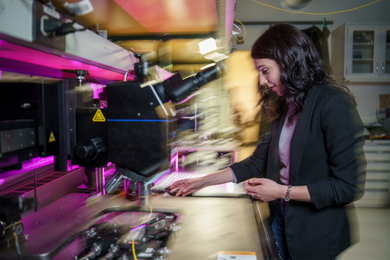Thousands of years after humans domesticated farm animals, they're moving on to a different sort of workhorse: molecules.
"About 10,000 years ago, man began to domesticate plants and animals. Now it's time to domesticate molecules," said Professor of Biology Susan Lindquist, director of the Whitehead Institute for Biomedical Research, at a recent conference on the subject of self-assembling peptides and proteins.
Lindquist studies yeast proteins to learn what makes them fold into the shapes they take and how to get them to fold differently to create new structures. Scientists have found that misfolded proteins called prions can influence the fate of cells, causing the daughter cells to create the same prions, which are believed to be a major culprit in amyloid diseases such as Alzheimer's, mad cow disease and scrapie, and may be a factor in smallpox.
"The fact that proteins can misfold and form amyloid diseases is an ancient problem. It means Mother Nature has taken advantage of it," said Lindquist. "We think that we can start taking advantage of protein misfolding ourselves to form protein systems in nanostructures," she continued in her presentation at this summer's workshop on "Self-Assembly of Peptides and Proteins in Biology, Medicine and Engineering" in Crete.
Peptides are strings of two or more amino acids held together by a particular chemical bond. Proteins are large strands of peptides linked together in an order specified by a cell's DNA. The order of linkage induces the protein to fold into specific, three-dimensional shapes that determine properties of the protein. The protein's configuration can be altered (denatured) when exposed to changes in its environment, such as heat or acidity.
In addition to the studying the causes of disease, scientists and engineers are learning to manipulate peptides and proteins, inducing these building blocks to self-assemble into biomaterials with particular properties (strong, brittle, elastic, smooth, etc.). Similar to the way a single silk thread gains strength when twisted with other threads, strings of peptides can be induced to fold, curl and twist, or bond together to form ropes or even tiny scaffolds on which other types of tissue can grow in vitro.
Unlike traditional work with molecules, which was solely the domain of biologists, bioengineering of this type requires a diverse set of scientists and engineers: biologists, materials scientists, mechanical engineers, physicists, computational engineers and mathematicians, among others.
Biology: the ultimate robotics
Sawyer Buckminster Fuller (S.B. 2000, S.M. 2003) studied mechanical engineering as an undergraduate because he was interested in robotics. But the more he learned, the more aware he became of the limitations of machines. He began looking at neuroscience to see what he could learn about the "brain of robotics." As he saw it, "what robots can do is extremely limited."
What did he learn?
"All the new stuff is in biology," he said. "Biology is the ultimate robotics. It's smarter than a computer. We can barely make robots walk at this point. [A cell] is like a robot and a factory built into one. You need lots of tools and machines to make a robot. With biology, it's all built in, and everything works at the molecular scale. I think that's really cool.
"I think of cells as a bag of chemicals and proteins that can work like a computer. DNA is the instruction that programs the proteins," continued Fuller, who is not related to the inventor of the geodesic dome but is named after him.
For his graduate work with Professor Joseph Jacobson of the Media Lab and mechanical engineering; Shuguang Zhang, associate director of the Center for Biomedical Engineering; and Professor Sebastian Seung of brain and cognitive sciences, Fuller designed an inkjet printer that could print with proteins.
"Replace the black pigment in your ink with proteins. Any kind will do, but we use mostly collagen because neurons stick to it," said Fuller, who adds that "neurons crawl all over the place. It's hard to know what they're gonna do."
Next he prints the protein ink in a pattern on a glass lab slide which he places in a petri dish. Then he adds neurons, which "sink to the bottom and instinctively stick to the collagen pattern and not the other part. We can watch how the neurons respond to the patterns and then try to figure out how to use that to connect them in certain ways. We want to figure out how they're computing."
Fuller presented a poster on his graduate research at the conference in Greece. He began his Ph.D. work at Caltech this month.
A version of this article appeared in MIT Tech Talk on September 10, 2003.






